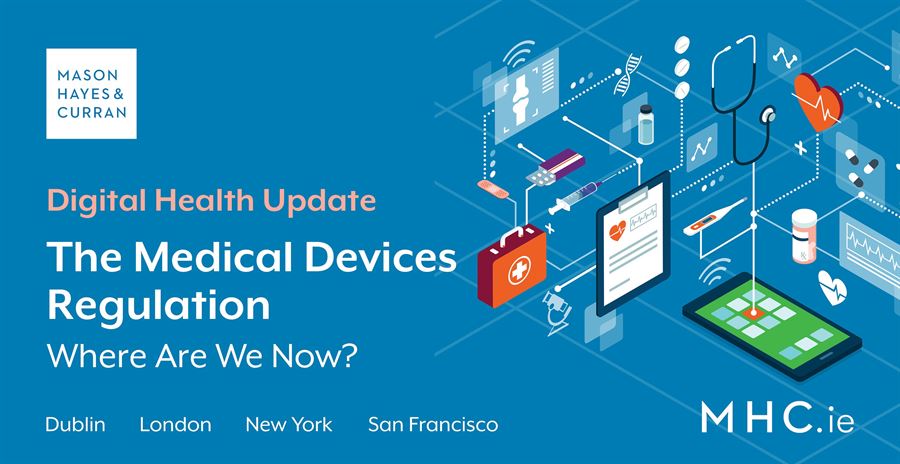
The Medical Devices Regulation (MDR) represents a significant development of the existing regulatory system for medical devices in Europe and will replace existing Directives which have been operative for over 25 years. As a Regulation, rather than a Directive, this EU legislation will be directly applicable without requiring transitional national legislation. This should provide for greater legal certainty and prevent variation in the approaches adopted between Member States.
The new Regulation seeks to overhaul the EU regulatory framework for medical devices, with the aims of improving clinical safety and creating fair market access for all manufacturers. Originally, it was set to come into force on 26 May 2020, however, largely due to COVID-19 this date has been extended by 12 months. This means that the MDR will now be fully applicable from 26 May 2021. The implementation of the In Vitro Diagnostics Medical Devices Regulation (IVDR) will also follow a year later and will be enforceable from May 2022. As a follow on to our previous articles tracking this important development, we examine what the MDR seeks to achieve and the position we have gotten to so far in advance of the revised date of implementation.
The MDR’s goal
The MDR addresses concerns over the assessment of product safety and performance by placing stricter requirements on clinical evaluation and post-market clinical follow-up, and by imposing enhanced requirements regarding traceability of devices throughout the supply chain. Manufacturers will be required to demonstrate that their medical device meets the relevant requirements through conducting conformity assessments which are dependent on the classification of their device. Once a product has passed the conformity assessment, only then can a CE marking be affixed. Notified Body approvals under these conformity assessments are required for Class IIa, IIb and III devices. Some Class I devices will require a conformity assessment by a notified body for parts relating to sterility or metrology.
The new MDR now requires total life cycle traceability between all stages of product development and post-market activities. Companies with low-risk Class I devices are required to produce a post-market surveillance report.
Labelling requirements have also been overhauled. General Safety and Performance Requirements (GSPR) checklists have been mandated. Information on warning, precautions or contraindications on devices have also been made mandatory as part of the labelling process. Labels require the EC representative’s name, address and symbol. Additionally, clinical evidence is now required for all medical devices. This involves extensive clinical testing in some cases.
The Corrigenda
There have been two corrections or corrigenda to the MDR.
The first Corrigendum was published in May 2019 in the Official Journal of the European Union (OJEU) and related to amending linguistic and other minor errors.
The second Corrigendum was prepared by the Council of the EU on 3 December 2019. This correction of the MDR amends Article 120, entitled the “Transitional provisions”. It permits manufacturers of Class I devices under the Medical Devices Directive (MDD), who will be up-classed under the MDR, to avail of a four-year transitional period. Accordingly, manufacturers will be able to place these devices on the market until May 2024 and are further allowed to make these devices available to end-users until May 2025. In order to avail of these transitional provisions, a device must obtain a CE marking as a Class I device under the MDD before 26 May 2021. In addition, no significant changes can be made to the intended purpose and design of relevant devices past 26 May 2021. Further guidance has been published on Article 120 by the Medical Device Coordination Group (MDCG), as discussed in further detail in a separate article in the Review.
Notified Bodies
The MDR has significantly increased the requirements which must be fulfilled before being designated as a notified body.
These new requirements relate to organisation and general requirements, quality management requirements, resource requirements and process requirements. The designation process involves national and European assessments, which can take up to 18 months to complete.
At the end of January 2020, over 85% of European Notified Bodies currently operating had applied for designation under the MDR, however at present, there are only 17 accredited notified bodies across Europe.
With 47 Notified Bodies still in the process of obtaining designation under the MDR, concerns had arisen about these organisations’ capacity to support medical device manufacturers’ European certification requirements past the original May 2020 compliance deadline. The one-year delay was hoped to have provided much needed time for pending submissions to get accreditation, however, there are still a significant number of Notified Bodies who are yet to receive MDR designation.
MDCG guidance documents
Throughout 2020 the MDCG has continued to publish guidance documents to assist stakeholders in implementing the MDR and with the objective of ensuring uniform application of the relevant provisions of the MDR. Since our last update, the MDCG has issued further guidance, bringing the total to over 60 documents, including the following published in the last few months:
-
A Position paper on the use of the EUDAMED actor registration module and of the Single Registration Number (SRN) in the Member States
-
Guidance for notified bodies on the use of MDSAP audit reports in the context of surveillance audits carried out under the MDR/ IVDR, and
-
Questions and Answers on MDCG 2020- 4: Guidance on temporary extraordinary measures on medical device notified body audits during COVID-19 quarantine orders and travel restrictions
EUDAMED
EUDAMED is a database designed to centralise and organise information on medical devices placed on the European market and is a critical component of the regime provided for under the MDR and IVDR. The European Commission launched the first of six planned modules making up the EUDAMED database in December 2020.
This first Actor Registration Module is addressed to the registration of economic operators and requires that manufacturers, authorised representatives and importers of MDR compliant devices (Actors) register their organisations and devices with their Competent Authorities. The Actor Registration Module is a prerequisite for the use of the other EUDAMED modules and facilitates a secure way of accessing EUDAMED. In August 2020 the MDCG published a position paper on use of the Actor Registration Module and a “frequently asked questions” document explaining the registration process was also released by the European Commission in December 2020.
Conclusion
The MDR seeks to significantly change the regulatory environment for medical devices with traceability, safety and proven usability at the forefront. The new Regulation is far more rigid and so, with only a few months to go, industry players should continue to prepare themselves for the 26 May 2021 deadline.
For more information on the Regulation and its anticipated implementation, contact a member of our Product Regulation or Life Sciences teams.
The content of this article is provided for information purposes only and does not constitute legal or other advice.






